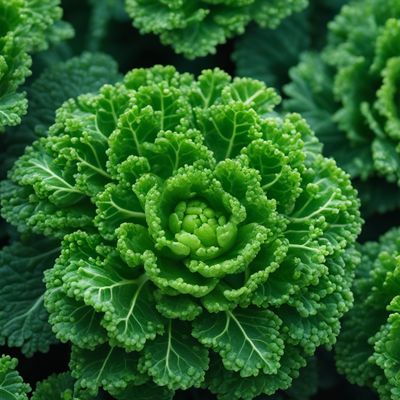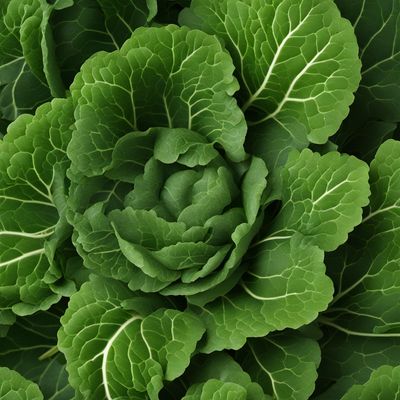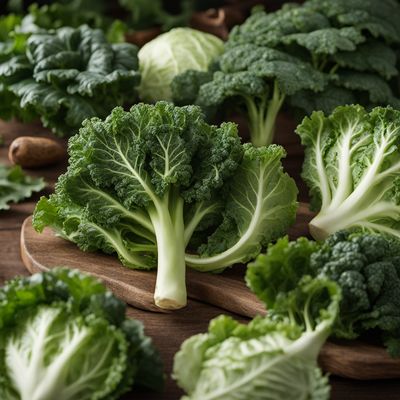
Ingredient
Kales and similar-
The Leafy Powerhouse
Kales and similar leafy greens, including kale, collard greens, and Swiss chard, are characterized by their dark green, sturdy leaves and slightly bitter taste. They have a crisp texture when raw and become tender when cooked. These nutrient-dense greens are rich in vitamins A, C, and K, as well as fiber and antioxidants.
Origins and history
Kales and similar leafy greens have a long history dating back to ancient times. Kale, for example, originated in the Mediterranean region and was a staple in Greek and Roman diets. Collard greens have roots in ancient Greece and were later brought to the Americas by African slaves. Swiss chard, on the other hand, has its origins in the Mediterranean and has been cultivated for centuries. These greens have been valued for their nutritional benefits and culinary versatility throughout history.
Nutritional information
Kales and similar leafy greens are low in calories and high in nutrients. They are excellent sources of vitamins A, C, and K, as well as calcium, iron, and fiber. A cup of cooked kale, for example, provides over 100% of the daily recommended intake of vitamin C and vitamin K.
Allergens
There are no known allergens associated with kales and similar leafy greens.
How to select
When selecting kales and similar leafy greens, look for vibrant, crisp leaves without any signs of wilting or discoloration. Choose smaller leaves for a more tender texture. Avoid any greens with yellow or brown spots, as they indicate age or decay.
Storage recommendations
To store kales and similar leafy greens, remove any rubber bands or ties and place them in a plastic bag with a few paper towels to absorb excess moisture. Store them in the refrigerator's crisper drawer, where they can stay fresh for up to a week. Avoid washing them until ready to use to prevent wilting.
How to produce
Kales and similar leafy greens can be easily grown in home gardens or containers. They thrive in cool weather and can be planted in early spring or fall. Provide them with well-drained soil, regular watering, and partial shade to ensure optimal growth.
Preparation tips
Kales and similar leafy greens can be enjoyed in a variety of ways. They can be sautéed, steamed, stir-fried, or added to soups, stews, and salads. Massage kale leaves with a bit of olive oil and lemon juice to soften their texture for raw salads. Collard greens are often braised or used as a wrap for fillings. Swiss chard can be cooked like spinach or used as a colorful addition to pasta dishes.
Substitutions
Spinach can be used as a substitute for kales and similar leafy greens in most recipes. Its mild flavor and tender texture make it a suitable replacement. Other substitutes include beet greens, mustard greens, or dandelion greens, depending on the desired taste and texture.
Culinary uses
Kales and similar leafy greens are commonly used in a variety of cuisines. They are frequently incorporated into salads, smoothies, and green juices. They are also popular in Mediterranean dishes such as spanakopita, Italian soups like ribollita, and African-inspired stews like collard greens with smoked turkey. Additionally, they can be used as a nutritious base for grain bowls or as a filling for wraps and sandwiches.
Availability
Kales and similar leafy greens are widely available in grocery stores, supermarkets, and farmers markets. They are cultivated in many regions around the world, including North America, Europe, and Asia.
More ingredients from this category

Rape kales
Vibrant and Versatile Rape Kales

Kohlrabi leaves
The Leafy Delights of Kohlrabi

Stem kale
The Versatile Green Powerhouse

Collards
The Mighty Collards

Black kale
The Mighty Leafy Green

Jersey kales
The Verdant Powerhouse of Nutrition

Portuguese kales
The Leafy Green Powerhouse

Curly kales
The Nutrient Powerhouse
